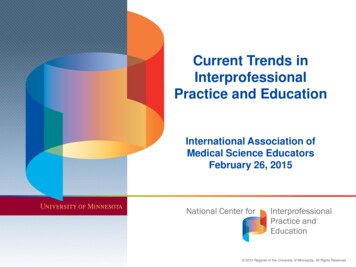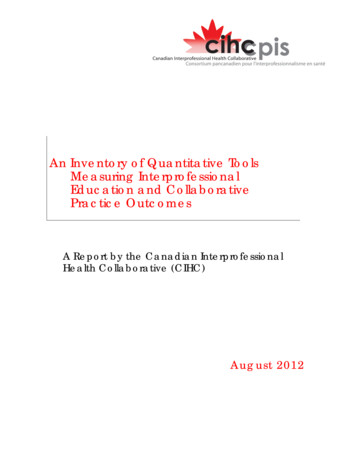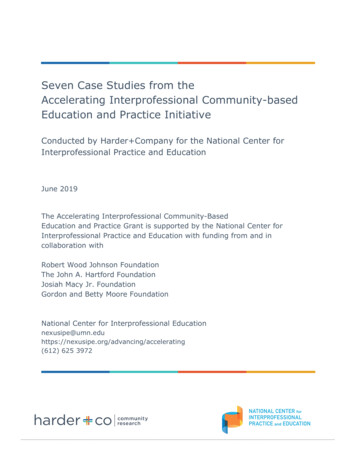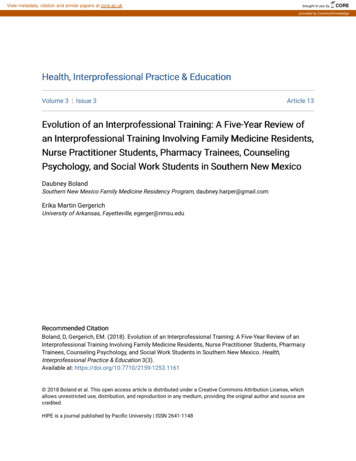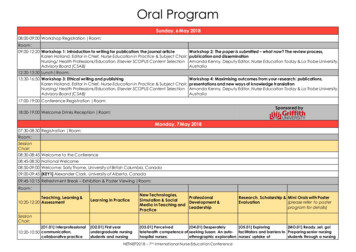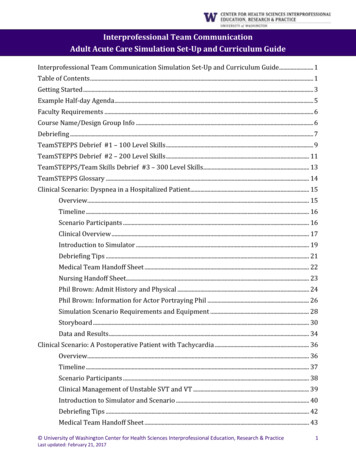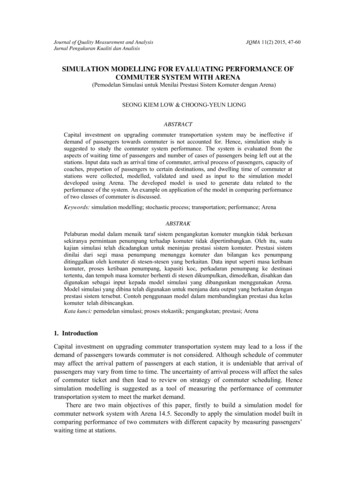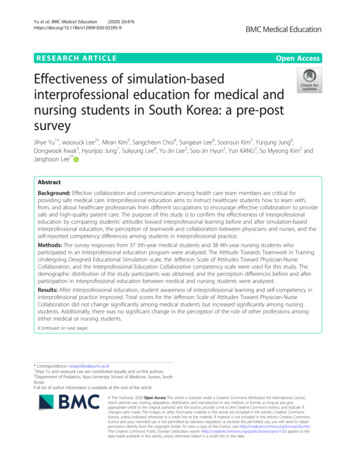
Transcription
Yu et al. BMC Medical Education(2020) SEARCH ARTICLEOpen AccessEffectiveness of simulation-basedinterprofessional education for medical andnursing students in South Korea: a pre-postsurveyJihye Yu1†, woosuck Lee2†, Miran Kim3, Sangcheon Choi4, Sungeun Lee4, Soonsun Kim5, Yunjung Jung6,Dongwook Kwak3, Hyunjoo Jung7, Sukyung Lee8, Yu-Jin Lee2, Soo-Jin Hyun2, Yun KANG2, So Myeong Kim2 andJanghoon Lee7*AbstractBackground: Effective collaboration and communication among health care team members are critical forproviding safe medical care. Interprofessional education aims to instruct healthcare students how to learn with,from, and about healthcare professionals from different occupations to encourage effective collaboration to providesafe and high-quality patient care. The purpose of this study is to confirm the effectiveness of Interprofessionaleducation by comparing students’ attitudes toward interprofessional learning before and after simulation-basedinterprofessional education, the perception of teamwork and collaboration between physicians and nurses, and theself-reported competency differences among students in interprofessional practice.Methods: The survey responses from 37 5th-year medical students and 38 4th-year nursing students whoparticipated in an interprofessional education program were analyzed. The Attitude Towards Teamwork in TrainingUndergoing Designed Educational Simulation scale, the Jefferson Scale of Attitudes Toward Physician-NurseCollaboration, and the Interprofessional Education Collaborative competency scale were used for this study. Thedemographic distribution of the study participants was obtained, and the perception differences before and afterparticipation in interprofessional education between medical and nursing students were analyzed.Results: After interprofessional education, student awareness of interprofessional learning and self-competency ininterprofessional practice improved. Total scores for the Jefferson Scale of Attitudes Toward Physician-NurseCollaboration did not change significantly among medical students but increased significantly among nursingstudents. Additionally, there was no significant change in the perception of the role of other professions amongeither medical or nursing students.(Continued on next page)* Correspondence: neopedlee@aumc.ac.kr†Jihye Yu and woosuck Lee are contributed equally and co-first authors.7Department of Pediatrics, Ajou University School of Medicine, Suwon, SouthKoreaFull list of author information is available at the end of the article The Author(s). 2020 Open Access This article is licensed under a Creative Commons Attribution 4.0 International License,which permits use, sharing, adaptation, distribution and reproduction in any medium or format, as long as you giveappropriate credit to the original author(s) and the source, provide a link to the Creative Commons licence, and indicate ifchanges were made. The images or other third party material in this article are included in the article's Creative Commonslicence, unless indicated otherwise in a credit line to the material. If material is not included in the article's Creative Commonslicence and your intended use is not permitted by statutory regulation or exceeds the permitted use, you will need to obtainpermission directly from the copyright holder. To view a copy of this licence, visit http://creativecommons.org/licenses/by/4.0/.The Creative Commons Public Domain Dedication waiver ) applies to thedata made available in this article, unless otherwise stated in a credit line to the data.
Yu et al. BMC Medical Education(2020) 20:476Page 2 of 9(Continued from previous page)Conclusions: We observed an effect of interprofessional education on cultivating self-confidence and recognizingthe importance of interprofessional collaboration between medical professions. It can be inferred that exposure tocollaboration situations through Interprofessional education leads to a positive perception of interprofessionallearning. However, even after their interprofessional education experience, existing perceptions of the role of otherprofessional groups in the collaboration situation did not change, which shows the limitations of a one-time shortterm program. This suggests that efforts should be made to ensure continuous exposure to social interactionexperiences with other professions.Keywords: South Korea, Interprofessional education, Medical student, Nursing studentBackgroundEffective collaboration and communication amonghealth care team members are critical for providing safepatient care. Many health care accidents are associatedwith communication problems within the health careteam and a lack of teamwork skills [1]. Interprofessionalcollaboration is important in that it increases job satisfaction of all health care team members including physicians, nurses and all allied health team members,positively affects patient satisfaction, and ultimately improves the quality of patient care [2, 3]. Implementationof interprofessional training within medical education isnecessary for ensuring patient safety. Within the healthcare team, interprofessional education (IPE) should beinitiated as an undergraduate course to cultivate effectivecommunication and collaboration skills among futuremedical personnel.IPE aims to instruct healthcare professionals how tolearn with, from, and about one another to encourageeffective collaboration for providing safe and high-qualitypatient care [4]. Thus, IPE can be implemented to improvestudents’ clinical performance so that effective communication, collaboration, and teamwork within the health careteam can be achieved in the clinical setting [5]. As awareness of its importance grows, IPE is being increasingly implemented in healthcare-process education and studieshave shown that through IPE, participating students developed a positive attitude toward interprofessional learningand that their collaboration skills improved [6].Use of simulations in IPE is increasing [7] and, with developments in medical technology, high-fidelity simulationis increasingly used as a teaching-learning tool for healthprofessionals [8]. Simulation is an effective tool for medicaleducation [9] because it can function like a real patient caresetting, and has been shown to improve students’ knowledge and communication skills [10, 11]. Simulation-basedIPEs are drawing attention in the medical field because theyprovide students’ with opportunities to collaborate, communicate, make decisions, and practice skills among theirteam members in life-like situations; additionally, studentscan experience the consequences that arise from theirdecisions [12]. Furthermore, simulation education allowsmedical practice to be performed in a safe environmentwithout the burden or pressures from the actual medicalenvironment [13]. A study conducted on students participating in interprofessional simulation [14] showed thatsimulation-based IPE fosters communication skills betweenprofessions, enhances understanding of other occupations’roles, enables collaboration, and improves self-confidencein collaborative situations, thus demonstrating its educational effectiveness.Despite the growing awareness of the importance ofSimulation-based IPE and related studies, there havebeen no cases in Korea where simulation-based IPE programs have been implemented and analyzed for medicaland nursing students who will play key roles withinhealthcare teams. The purpose of this study is to analyzethe educational effect of simulation-based IPE for medical students and nursing students in Korea. The specificresearch questions are as follows:– What is the attitude of medical and nursing studentsto professional training, awareness of teamwork, andcollaboration within the health care team, andcompetency for interprofessional collaborativepractice?– Are there pre- and post-training differences in students’ attitudes toward inter-professional training,awareness of teamwork and collaboration within thehealth care team, and competency for interprofessional collaborative practice?MethodsDesignThis study evaluated pre- and post-measures throughquantitative surveys completed by medical and nursingstudents who participated in a high-fidelity simulationbased interprofessional program.Ethical considerationsThis study was approved by the Institutional ReviewBoard (IRB) of Ajou University Hospital (Ethics consentNo. AJIRB-SBR-SUR-20-125).
Yu et al. BMC Medical Education(2020) 20:476SettingThe simulation-based interprofessional program conducted from November 26–27, 2019 consisted of a totalof three sessions: an adult simulation scenario with a patient complaining of chest pain (Module 1), a maternalscenario of a postpartum hemorrhage (Module 2), and apediatric scenario in which a child presents with mildviral croup (Module 3). Module 1 aimed to collect information from patients complaining of chest pain to ateam of emergency room doctors and nurses who performed the initial treatments. The Module 2 scenariowas structured to test students’ ability to recognizechanges in a patient with postpartum hemorrhage andtheir ability to engage in effective therapeutic communication with team members so that necessary medicalprocedures can be performed effectively. The Module 3scenario aimed to evaluate the health care team’s abilityto recognize symptoms in a child with febrile seizuresymptoms due to viral croup and their ability to employthe necessary medical treatment skills, and to collaborateand communicate among the health care team. Eachsimulation module used in this study was determined bycoordinating the medical and nursing faculty among therequired graduation achievements of the university, andthe simulation scenario was completed by adjusting thedifficulty level through consultation. Although the scenario cases for each module are different, the task to beperformed is the same, including diagnosis, treatmentplanning, and treatment action for patients throughcommunication and collaboration between physiciansand nurses. Therefore, the module was constructed sothat students would have almost the same experience nomatter which of the three modules they participated in.ProceduresA total of 87 students, including 43 medical studentsand 44 nursing students, participated in the simulationbased IPE program. Students were divided into 22groups of 3–4 students per group. The 21 teams consisted of 2 medical and 2 nursing students each, and 1team consisted of 1 medical and 2 nursing students.Two of the three modules were randomly assigned toeach team. Therefore, each team experienced a total oftwo scenario modules. The format and contents of eachsimulation session are shown in Table 1. In the pre-Page 3 of 9briefing session, the instructor explained the aims andprocess of the program to the participating students. Inaddition, a simulation scenario template was provided tostudents so that they can check the scenario setting,learning outcome, description of scenario, and patientinformation. In the pre-scenario session, students set upa plan for actual simulation, such as analyzing cases andassigning roles based on a given scenario template. Inthe task training session, students practiced tasks necessary for actual performance such as checking manikinand equipment in the simulation room. In the simulation session, students intervened according to manikinactions based on programming data, and in this process,team members communicated and collaborated witheach other. The students in the previous group who experienced the simulation module performed peer evaluation while watching what the students in the nextgroup did. Through peer evaluation, students were ableto reflect on their own performance, which serves as adebriefing. In addition, after the simulation session ofeach module was over, debriefing was conducted withthe instructor on the performance of the group.ParticipantsA total of 87 students participated in this program, 43medical and 44 nursing students. The data of participating students who did not respond to or responded insincerely to the survey to verify the effectiveness of thisstudy were excluded. Thirty-seven fifth-year medical students and 38 fourth-year nursing students participatedin the IPE program, and a total of 75 response variableswere used for the analyses. Medical students in the 5thgrade have competencies for essential treatments andclinical skills through major clinical clerkship, and havebasic competencies for coping with emergency situations. In addition, the 4th grade nursing students havecompleted all clinical practice and have the basic knowledge and skills required in the medical situation at thehospital. In other words, it can be seen that the participants of this study are at the stage before entering thejob and have the ability to evaluate their own capabilities. Missing responses or insincere responses were excluded. Students completed the questionnaire beforeand after IPE participation.Table 1 Components of the simulation sessionsSession componentTimeContentPre-briefing20 minIntroduction program objectives and operational processes, and obtain consent to record simulationsPre-scenario activities20 minSituation analysis, coping plan, role sharing, and necessary task determinationTask training20 minRequired task practiceSimulation20 minScenario performance (different groups performed different modules), peer evaluationDebriefing20 minShare thoughts on interprofessional experience
Yu et al. BMC Medical Education(2020) 20:476MeasuresIn our study, the attitude toward interprofessional learning was measured using the Attitude Towards Teamwork in Training Undergoing Designed EducationalSimulation (ATTITUDES) scale which was developed bySigalet et al. [15]. This scale consists of 30 items organized into five sub-factors: IPE relevance (7 items, e.g., Iwant more opportunities to learn with other professionals.), simulation relevance (5 items, e.g., Simulationis a good tool for practicing team decision-makingskills.), communication (8 items, e.g., Communicationwithin the team is as important as technical skills.), situation awareness (4 items, e.g., Patient care is improvedwhen all team members have a shared understandingabout assessment and treatment.), and roles and responsibilities (6 items, e.g., Monitoring what each team member is doing is important for optimizing patient safety.).Each question was measured on a five-point scale from“strongly disagree” (1 point) to “strongly agree” (5points). It can be seen that the higher the total score, themore positive students’ attitude toward interprofessionallearning through simulation-based IPE. In this study, thepre and post-IPE questions show internal consistency(Cronbach α 0.962 and 0.985, respectively).To measure the perception of teamwork and collaboration between physicians and nurses, Jefferson Scale NC) developed by Hojat et al. [16] was used in thisstudy. This scale consists of 15 items and 4 sub-factors:shared educational and collaborative relationships (7items, e.g., Interprofessional relationships between physicians and nurses should be included in both professions’educational programs.), caring as opposed to curing (3items, e.g., Nurses are qualified to assess and respond topsychological aspects of patients’ needs.), nurse’s autonomy (3 items, e.g., Nurses should be accountable to patients for the nursing care they provide.), and physician’sauthority (2 items, e.g., Doctors should be the dominantauthority in all healthcare matters.). Each item was measured on a four-point scale from “strongly disagree” (1point) to “strongly agree” (4 points). The higher the totalscore, the more positively students perceive teamworkand collaboration between physicians and nurses. TheCronbach α for inter-consistency before and after IPEwas 0.911 and 0.935, respectively.The Interprofessional Education Collaborative (IPEC)Competency self-assessment tool developed by Lockeman [17] was used to measure students’ competency ininterprofessional practice. This scale consists of two subfactors: interprofessional interaction (7 items, e.g., I canuse strategies that will improve the effectiveness of interprofessional teamwork and team-based care.) and interprofessional value (9 items, e.g., I can embrace thediversity that characterizes patients and the healthcarePage 4 of 9team.). Each item was measured on a 5-point Likertscale from “strongly disagree” (1 point) to “stronglyagree” (5 points). It can be seen that the higher the totalscore, the more students perceived as more competentin interprofessional practice. The Cronbach α for competency before and after IPE was 0.957 and 0.980,respectively.AnalysesDescriptive statistical analyses were conducted to identify the demographic distribution of participants in thisstudy, and t-tests were conducted to explore responsedifferences between the professional groups of medicaland nursing students. Additionally, paired t-tests wereconducted using SPSS version 25.0 (IBM, Armonk, NY,USA) to identify changes in medical and nursing students’ scores before and after IPE participation.ResultsDemographicsParticipant characteristics are presented in Table 2.There were 1.7 times more male students than femalestudents among the medical-school respondents, whilethere were 4 times more female students than male students among the nursing-school respondents. Medicalstudents had no prior experience in simulation training,but nursing students had undergone previous simulationtraining. None of the participating students had any educational experience with other professions.ATTITUDES, JSAPNC, and IPEC Competency scoresaccording to profession are presented in Table 3. Thedifferences between ATTITUDES, JSAPNC, and IPECCompetency were compared and analyzed for both student groups before and after IPE. Nursing studentsscored higher than medical students in ATTITUDESand IPEC Competency before and after IPE. The twogroups did not differ significantly in JSAPNC scores before or after IPE.The results of comparative analyses of the differencesbetween the ATTITUDES, JSAPNC, and IPECTable 2 Participant demographic data (N 75)MedicalNursingMale247Female1331GenderPrevious experience with simulation sessionsYes038No370Previous experience with interprofessional educationYes00No3738
Yu et al. BMC Medical Education(2020) 20:476Page 5 of 9Table 3 ATTITUDES, JSAPNC, and IPEC Competency scoresaccording to professionATTITUDESJSAPNCIPEC Competency4.18 (0.48)3.25 (0.38)3.97 (0.66)Nursing4.50 (0.39)3.36 (0.42)4.48 (0.49)t3.15**1.143.77***4.45 (0.73)3.36 (0.60)4.36 (0.78)Nursing4.77 (0.29)3.52 (0.35)4.78 lRange of score: ATTITUDES (1–5), JSAPNC (1–4), IPEC Competency (1–5)*p 0.05, **p 0.01, ***p 0.001Competency scores before and after IPE experience arepresented in Fig. 1.All students participating in interprofessional education showed significant improvement in ATTITUDES,JSAPNC, and IPEC competency scores. Before the interprofessional education, the average scores of each scalewere ATTITUDES (M 4.34, SD 0.47), JSAPNC (M 3.30, SD 0.40), and IPEC Competency (M 4.23, SD 0.63). After the program experience, the score of eachscale was found to increase significantly as follows:ATTITUDES (M 4.61, SD 0.57, t 4.63***), JSAPNC(M 3.44, SD 0.50, t 2.87**), and IPEC Competency(M 4.57, SD 0.63, t 5.25***).Table 4 shows the ATTITUDES, JSAPNC, and IPECCompetency scale scores for medical and nursing students before and after participating in IPE programs.The overall score for nursing students was higher thanthat for medical students, but the score for physician’sauthority, one of the sub-factors of the JSAPNC scalewas higher among medical students (pre: M 2.80 vs.M 2.57, post: M 2.92 vs. M 2.72).The total scores from ATTITUDES (t 2.50, p 0.05vs. t 5.32, p 0.001) and IPEC Competency (t 3.44,p 0.01 vs. t 4.34, p 0.00) increased significantly afterIPE in both medical and nursing students. The totalscore for JSAPNC showed no significant change amongmedical students, but a significant increase among nursing students (t 3.02, p 0.01). Regarding changes inscores before and after IPE by JSAPNC sub-factors, in“shared educational and collaborative relationships,”which both measure the perception of collaboration between physicians and nurses, the scores from both medical students and nursing students increased (t 2.36,p 0.05). vs. t 3.64, p 0.01). For medical students,however, there was no change in scores for caring as opposed to curing, nurse’s autonomy, or physician’s authority, which measures the identity of each professiongroup. Also, there was no significant change in the scorefor physician’s authority among nursing students.DiscussionWe found that nursing students were more positivelyaware of interprofessional learning and competency ininterprofessional practice than medical students. Priorstudies that compared the impact of IPE experience onthe perception of interprofessional learning between thedifferent professional groups have yielded mixed results.A study that compared attitudes to interprofessionallearning before and after IPE [15] for different professional groups showed that medical students had morepositive attitudes toward IPE than nursing students,which is a contrary finding to this study. This meansthat certain profession, nurses or physicians, do notFig. 1 Comparison of ATTITUDES, JSAPNC, and IPEC Competency scores before and after simulation-based interprofessional education
Yu et al. BMC Medical Education(2020) 20:476Page 6 of 9Table 4 Comparison of pre- and post-simulation scores for interprofessional education between medical and nursing studentsScaleMedical (n 37)ATTITUDESRelevance of IPERelevance of SimulationCommunicationSituation awarenessRoles and responsibilityTotalJSAPNCShared educational and collaborative relationshipsCaring as opposed to curingNurse’s autonomyPhysician’s authorityTotalIPEC CompetencyInterprofessional interactionInterprofessional valueTotal*p 0.05, **p 0.01,Nursing (n 38)M (SD)tM (SD)tPre4.10 (0.53)2.35*4.39 (0.47)5.33***Post4.35 (0.76)Pre4.16 (0.60)Post4.46 (0.76)Pre4.21 (0.54)Post4.46 (0.75)Pre4.15 (0.49)Post4.45 (0.78)Pre4.27 (0.57)Post4.53 (0.76)Pre4.18 (0.48)Post4.45 (0.73)Pre3.29 (0.49)Post3.51 (0.59)Pre3.37 (0.47)Post3.43 (0.63)Pre3.55 (0.47)Post3.58 (0.60)Pre2.80 (0.65)Post2.92 (0.99)Pre3.25 (0.38)Post3.36 (0.60)Pre3.85 (0.78)Post4.31 (0.83)Pre4.10 (0.62Post4.41 (0.76)Pre3.97 (0.66)Post4.10 (0.53)4.75 (0.31)2.61*4.43 (0.49)4.68***4.81 (0.33)2.09*4.61 (0.38)4.34***4.85 (0.29)2.36*4.45 (0.49)3.51**4.67 (0.41)1.904.61 (0.45)3.24**4.80 (0.33)2.50*4.50 (0.39)5.32***4.77 (0.29)2.36*3.59 (0.40)3.64**3.77 (0.32)0.683.60 (0.49)2.82**3.79 (0.37)0.303.68 (0.44)2.37*3.81 (0.37)0.812.57 (0.86)1.182.72 (0.83)1.363.36 (0.42)3.02**3.52 (0.35)3.52**4.38 (0.60)4.31***4.71 (0.41)2.93**4.58 (0.46)3.82***4.85 (0.30)3.44**4.48 (0.49)4.34***4.39 (0.47)***p 0.001always have a more positive attitude toward interprofessional learning than others. What direct or indirect experiences they had in patient care settings in previousclinical practice may be more important factors for attitude toward interprofessional collaboration and interprofessional learning [18].Prior to this study, neither the nursing- nor medicalstudent participants had IPE experience, but medicalstudents had 1 year of clinical experience practice, whilenursing students, who were at the end of their fourthyear, had almost 2 years of clinical experience practiceand the nursing students had previously undertakensimulation in clerkship. Clinical experience practice provides positive and negative role modeling observationsand collaboration among doctors, nurses, and other relevant allied health practitioners [19], and extensiveexposure to situations that require collaboration withother professional groups may affect students’ perceptions of interprofessional learning [20]. It can be understood in the same context that the more experiencedclinical practice, the higher the self-competency in interprofesssional practice. Therefore, one interpretation ofour results is that nursing students with more clinicalexperience practice responded more positively towardinterprofessional learning and self-competency in interprofessional situations than medical students. Aftersimulation-based IPE, the attitude toward interprofessional learning for all participating professions improved.These results are consistent with a prior study [21] inwhich a simulation-based IPE program had a positive effect on the attitudes of medical and nursing students toward IPE. Additionally, after simulation-based IPE, the
Yu et al. BMC Medical Education(2020) 20:476perception of all students who participated in teamworkand collaborations between physicians and nurses hadimproved.However, sub-analyses of only medical students andonly nursing students revealed no change in medical students’ perception about nurse autonomy nor nursingstudents’ perception about physician authority accordingto factors measuring perceptions of professional identity.In other words, we observed no change in students’ perception of the professional identities of the different profession groups, which is in contrast with a previousstudy [22, 23] that found changes in stereotypes of otherprofessions after IPE. We infer that this is due to thecultural contexts of the rigid Korean medical organizations. Two days of short-term IPE is unlikely to changestudents’ perceptions of the roles of other professionscompared to what they learned through their clinicaltraining in the hospital. The point of focus between physicians and nurses is different in the clinical settings, thephysicians are in charge of a directive role that makesthe overall decision-making, and the nurse takes on asubservient role that focuses on patient care [24]. Ourfindings suggest that existing stereotypes about specificprofessions are challenges to be overcome in interprofessional learning. Beyond short-term special programs, itis necessary to include interprofessional collaborativetraining in clinical practice so that students can fullyunderstand the role of other professions through theprocess of experiencing, observing, interacting, andreflecting positive modeling [25, 26].After simulation-based IPE, self-reported competencyimproved for both medical and nursing students.Through IPE, students improved their ability to communicate and solve problems collaboratively among theirhealth care team, and to understand team members andperform patient-centered care more effectively. A priorstudy [27, 28] found that interprofessional simulationimproved self-competency in communication, collaboration, and situation management among team membersin clinical settings. Competency development is a keycomponent of clinical training [29]. Continuousprovision of IPE improves competency, which helpspostgraduates perform proficiently in their field of patient care. Patient care in clinical contexts always requires effective teamwork and communication skillsamong the health care team. However, because thecurrent university education system is centered on majors, the necessary qualities for collaboration are insufficiently cultivated. IPE could be a good alternativeapproach to fill this learning gap.This study is meaningful in that it is an empirical studythat identified the educational effects of simulation-basedIPEs in Korea, where IPE education has not yet beenenacted. This study evaluated the educational effects of IPE,Page 7 of 9but this study has limitations in that it is a study on a singleand short IPE. In order to analyze the effects of IPE in moredetail, it is necessary to conduct IPE periodically and thenperform analysis based on accumulated data. In addition, inanalyzing the effects of the IPE program, there are limitations in that there may be various factors that can affect thestudy results in addition to the factors considered in thisstudy. It is necessary to conduct a follow-up study that considers more various related variables such as studentachievement. This study also has limitations in that it usedan outdated scale that was developed to investigate the perception of teamwork and collaboration between physiciansand nurses. When using it in future research, it is necessaryto consider using it after going through an appropriate revision for the item according to the current situation. It alsohas an important limitation, in that it did not evaluate howlong the effects of IPE will last. A reliable estimate of the effect duration is important for setting the cycle of education.It would then be necessary to conduct a study among postgraduates who participated in IPE as students to periodically evaluate the persistence of the educational effects ofIPE. Additionally, in the long-term, when students embarkon real clinical work after graduation, it is important toconduct research to evaluate whether healthcare professionals who had IPE experience during their training showbetter clinical performance through effective teamwork andcommunication.ConclusionsThis study was conducted to assess attitudes toward interprofessional learning, perception of teamwork andcollaboration between doctors and nurses, and selfreported competency of students in interprofessionalpractice, and to compare the differences before and aftersimulation-based IPE. Through IPE, students’ attitudetoward interprofessional leaning and self-competency ininterprofessional practice were improved. The perception of teamwork and collaboration between physiciansand nurses showed no significant change among medicalstudents but increased significantly among nursing students. Additionally, there was no signifi
and 44 nursing students, participated in the simulation-based IPE program. Students were divided into 22 groups of 3-4 students per group. The 21 teams con-sisted of 2 medical and 2 nursing students each, and 1 team consisted of 1 medical and 2 nursing students. Two of the three modules were randomly assigned to each team.
